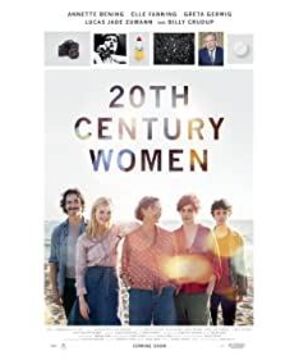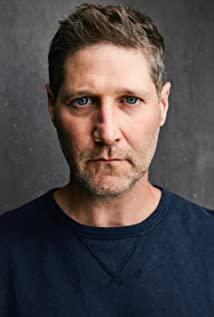I've been following this film since the end of '15 purely for Benin's sake. Similar to many people who have only seen the trailer or even the synopsis, I initially thought this was just another semi-biographical film with the theme of "Family - Youth Growth". But after watching it, I think that such a label, if not wrong, at least misses the point of the movie,
even though the movie is just a microcosm of the lives of residents in a small neighborhood in Southern California in the late 1970s, a certain period of time The details, the bits and pieces, but in the subtleties, reveal the "real protagonist" of the film (also written above the title of the film): Does the story of 20th Century
Intersubjectivity
have a narrative body? ? I don't think so. Whether it is the mother Dorothea who seems to be the "protagonist", or the son Jamie, or around the other two important women in Jamie's life: Julie and Abbie, and even the old hippie driver William, they have obtained quite a lot of personal monologues. All five main characters are given space (though not necessarily enough) to describe their respective upbringings, life courses, personalities
If this is just a movie about "teenage growth", then not only should it not be called "Twentieth Century Women" (it should be called "Punk Boys in the Late 70s"), but for other characters other than Jamie, it should be There shouldn't be so much narrative and inner psychological portrayal. We can take "Boyhood" as a comparison: "Boyhood" is undoubtedly a standard youth growth film, because it completely looks at the world from the perspective of little Mason; it can even be said that the other characters in "Boyhood" are just Little Mason's "cognitive background"-whether it's his mother Liv or his father, Mason, their plot basically exists when little Mason is also present at the same time. What is shown in the film is the world in the eyes of little Mason; almost all conflicts in the film are the conflicts witnessed by little Mason.
However, in "20th Century Woman", mother Dorothea, son Jamie, childhood sweetheart Julie, punk girl Wen Qing Abbie and even William, they all have their own stories, each of which is either indirectly "heard" by Jamie, or directly explained by these characters in their own monologues. What these stories connect and construct is not the world in Jamie's (or Dorothea's) eyes, but the world in their own eyes. This perspective has a certain "privacy", and at the same time, the director also repeatedly implies this privacy through a certain type of composition that appears many times in the film (more on this later),
but the film has an inherent wholeness. It is not a collection of fragments of the inner monologues of five separate, separate characters; what integrates them, of course, is the direct interpersonal communication between these characters, the social network-field they form. But I thought that what really connected them was the
photography and composition of that era. The photography of
this film was actually very simple. Slightly fancy, at most adding filters to some shots in post (in this film, there are about four special effects of cars dragging colorful blurred images while driving on the road)
This is probably equivalent to adding a motion blur filter + graduated filter...
In addition, there are many down-motion shots (fast-moving shots) in the film (and sometimes mixed with dolly or tracking shots, resulting in effect of time-lapse photography). For example, Julie came to the rescue when Jamie fainted. It is worth noting that almost all the downgraded scenes appear in the plot with characters narrating. What does it mean?
In Carter's televised speech mentioned later, the director's insertion of "Life Disorder" uses a down-and-fast shot. The meaning is very clear: modern society is in high-speed operation, fast production, fast consumption, fast pace of life. Therefore, the film uses a lot of degraded shots. The first meaning, I think, is at the micro-personal level, and it also expresses this kind of experience of rapid change and change of things. The twentieth century, as the title of Hobsbawm's book puts it, was an "era of extremes": extreme conflict, extreme quest for freedom, extreme war and death, extreme efficiency, extreme society change.
And when this degraded scene, which is different from our natural human experience, appears in front of our eyes, it is accompanied by a slow-paced narration of the movie characters that conforms to the "normal" human experience, a strong sense of conflict (abnormal) Visual experience + normal sound experience) will appear - the sense of conflict stimulates the audience's attention (the so-called "principle of contrast & affinity"). So that's what I think is the second meaning of using downgrade shots in this film.
The film's most "eye-catching" camera technique is also the simplest dolly in/out. A good portion of the push-pull shots take place indoors, or even outdoors, with visual elements forming an internal frame [Example: Julie is selling makeup in a mall 35 minutes and 45 seconds later]. The purpose of the inner frame is obvious: to force the viewer's visual attention to be within the frame. The slow sliding mirror, accompanied by the dynamic movement of the characters in the frame, also creates a strong contrast (again using the "contrast-similar principle"). Just find a few examples:
①Julie attends a psychotherapy class hosted by her mother. Advance (36 minutes 40 seconds)
Similar scenes appeared many times. Notice that the camera is always pushing and pulling from the doorway of the psychotherapy room. In this example, one patient was out of control and banged on the stakes violently; the others just sat silently. The camera moves slowly, gradually seeing the pain of the patient and the powerlessness of others (including the psychiatrist)
②Abbie and Jamie dance frantically to the music of the tape (48 minutes 16 seconds)
The camera repeatedly pushes and pulls in this shot. The contrast is very strong, the cheerful movement of the two + the slow push and pull of the mirror. But in this shot, there is no visual element to "frame" the two, so how do you create an internal frame? Pay attention to the door frame between the two in the background. This door frame bisects the shot, with an inner frame on each side.
Earlier I mentioned that the stories of the characters constructed by the director in the film are private. It is reflected in the composition of this shot: Abbie and Jamie are hiding in the house listening to punk music, which is a "secret" that belongs to the two people's common hobby, a common but exclusive memory of the two people
③ Dorothea and William dancing in the bedroom . Pull out (79 minutes 07 seconds)
The two danced to the music of "art-fag", looking very cheerful. Pulling out allows the viewer's attention to shift from a part (a corner of the bedroom) to the whole bedroom including the doorway. Similarly, the "privacy" in this shot is reflected in: the bedroom as a private space, dancing cheerfully, and the ambiguous relationship between Dorothea and William ④ Dorothea
smoking a cigarette alone at the dining table. Pull out (13 minutes 24 seconds)
The things included in the shot extend from the local point of the dining table to the entire kitchen. As a single mother, Dorothea faced the hardships (kitchen = "daily life") in order to maintain her family's survival. She could only bear it alone
. ⑤ Jamie and Dorothea quarreled on the road, and Jamie left in anger. Pull out (22 minutes 19 seconds)
Purely from a photographic point of view, this lens feels a little weird. Because this is a less obvious flat space, the depth cues are eliminated more.
In the plane space, there is a concept in cognitive
sociology called "cohort" in an era where sliding mirrors are generally not used . In an analysis, the population in the same time period is regarded as a sample set. Analyze their characteristics. For example, I read an NBER paper a few years ago that analyzed whether Americans born at different ages had different risk appetites for investing; the authors of that paper found that growth during the Great Depression Americans, who are more conservative
in their investment style, can be roughly divided into three cohorts (although there is actually only one "sample" in each sample set):
A. The generation born before the war (born in 1924) Dorothea of Dorothea; William's birth year cannot be "verified", but it is estimated to be later)
B. Post-war mid-baby boomer (Abbie born in 1955)
C. Late post-war baby boomer (Julie born in 1962 and 1964 1. According to the age
group of the American population, Americans like Dorothea are called the "silent generation". They grew up during the Great Depression, and their youth was spent in World War II; when they grew up and went into society, it happened to be when the so-called "baby boomer" generation appeared, and of course the Truman-Eisenhower economy. Relatively prosperous times; yet as they enter middle age, they are faced with a "boom and bust" America (okay, that's a bit of an exaggeration, but suppose you're a Johnson-Nixon-era American, right? feel that way?). Their generation has experienced many ups and downs, and they are also a generation of contradictions: conservative and open, happy and sad, both individual and collective
Dorothea is the epitome of this generation: she's both conservative (Abbie is not allowed to talk about sex with her son), open (actively understands what kind of music her son likes, first-generation women in the workplace), and happy (often warmly invites just Knowing people go to her house to eat and chat, talk humorously) and sad (smoking alone, meditating), both individual (daring to defend his son's skipping class) and collective (as Jamie put it, people in the Great Depression were "raised by everyone." Everyone's children" - so this collective consciousness somewhat led Dorothea to ask
Abbie and Julie to "assist" her to "raise" Jamie) punk music, and seeing the crazy shaking drummer (and the audience) on stage, she suddenly felt emotional. She's not just lamenting how different the pop culture of her son's era is from her (she once said "every day I don't know him more and more"), but she's looking at it from the point of view of someone who's been there - everything that's solid It all vanished: even today's legitimate pop culture was quickly replaced by a newer one; the once-dominant liberal beliefs were quickly taken away by Reagan and his neoconservatives. She's certainly qualified to say this: Because she's seen (almost) the entire Twentieth Century
2, Abbie and Julie are both baby boomers, but the roughly 7-year time difference has resulted in slightly different personalities. Baby boomers grew up after the war, when they were teenagers, through the assassination of JFK, the Johnson-Nixon era, the Vietnam War, sexual liberation, hippies... I'm a "foreigner" (as opposed to the US) to count The difference
between Abbie and Julie is that the former represents a generation with more or less ideals of social change. Abbie is similar to Dorothea in this regard (though in a very different way and purpose). Dorothea's ideal is first to become a female Air Force pilot, and then to become the first generation of women in the workplace. This is the standard "combination of personal ideals and social ideals"; however, as a punk female literary youth who has been immersed in various academic theories in New York, Abbie's Personal ideals clearly contradict social reality, so she wanders around until she encounters the Jamie/Dorothea family.
Abbie's "change the world" theory is feminist, and the method is to change the men around him, especially Jamie. Take Jamie to nightclubs, teach him to pick up girls, listen to records from various bands, and most importantly: give Jamie various feminist readings. If Dorothea’s generation achieved formal equality of women’s material status (“I can do it too”), then what Abbie’s generation women want to achieve is equality between men and women in social status and even spirituality (“I can do it too”). can also have").
Under the influence of Abbie , Jamie can at least understand women and think differently from a woman's point of view Generation X - What is Generation X like? "The Four Graduates" by Winona Ryder when she was young is an excellent portrayal.
Julie seems to be the representative of a generation that has completely lost its ideals. Dorothea used the word "boredom" to describe Jamie's generation, but Julie is more worthy of the word than Jamie. Not only because of Julie's promiscuity, but also because of the confused mentality behind her promiscuity (50% disappointed "theory"). Julie, like Abbie, is concerned with women's sexuality, but Abbie is concerned with changing women's subordination in sexuality, and Julie is concerned with her own sexual experience as a woman - why sex ? If it was Dorothea's generation, the answer might be "because of love"; if it was Abbie's generation, the answer might be "because women's vaginas need to be liberated", while Julie's answer is a bit confusing: the boy looks at you Eyes, small voices, their youthful carcasses... to know what they (males) are like, so experience sex
Jamie and Julie ran outside to open the room and seemed to finally have a blast. But Julie, who was already naked, said "no" to Jamie at the last moment: we couldn't have sex because we were too close. Jamie says "I want more than sex, I want you" - a statement that seems to transcend carnal desire. Yet Julie said: "You're just like any other guy, just more "modern". This "modern" seems to be more like an unconscious "sarcasm" of Abbie; after all, Abbie "armed" Jamie with feminist theories, and Jamie should be a good man who is more considerate and understands women. However, Julie (and maybe this generation of women) doesn't need your men's "understanding" ("It'd be a lot better if you just wanted sex")
4. There is a scene where everyone watches President Carter's televised speech . In his speech, Carter attacked consumerism and the "false concept of liberty", which will lead society to skepticism and the country to division. Mike Mills inserted footage from Godfrey Reeggio's documentary "Life Disorders" in his speech, giving a "visual presentation" of Carter's speech theme. Carter stepped down after a year, and the plot of this televised speech ostensibly satirized that Carter, as president, could do nothing about the crisis. However, as Carter's peer (also born in 1924), Dorothea felt that the speech was "beautiful".
She probably understood what Carter wanted to say, or she also had similar confusion as Carter. The confused film of the human society of the century
seems to end with some unfinished regret, and everyone reveals the ups and downs of their future through monologues. "Future" Jamie finally said: He would try to explain to his son what kind of person his grandma was, but he couldn't . After all,
all he knew was Dorothea as a mother, not a complete Dorothea, the changing woman of the tenth century
View more about 20th Century Women reviews











